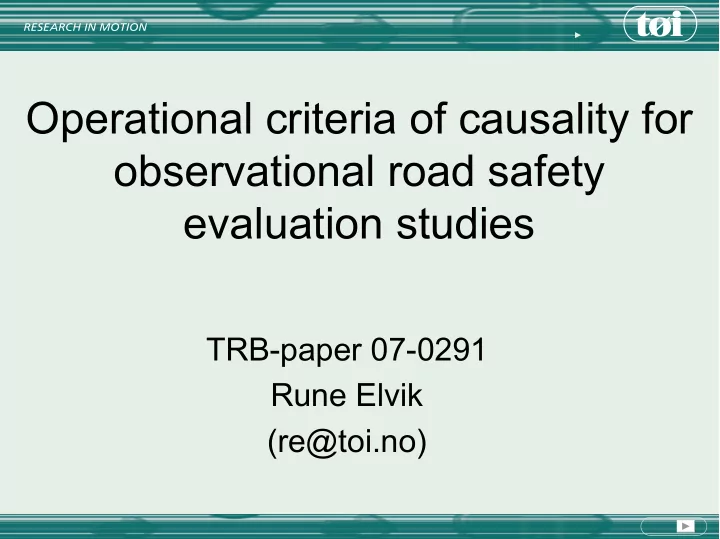

Operational criteria of causality for observational road safety evaluation studies TRB-paper 07-0291 Rune Elvik (re@toi.no)
Main problems to be discussed • Are there any criteria of causality for observational road safety evaluation studies? • How clear and conclusive are these criteria? • Motivation: Nearly all road safety evaluation studies are observational (non-experimental)
Correlation ≠ causation • A statistical relationship (correlation) is generally regarded as a necessary condition for a causal relationship • But not all statistical relationships are causal • To cause: to produce a change that would otherwise not have occurred
Criteria to be discussed 1. Statistical relationship: an effect must exist 2. Strength of relationship: the effect must be greater than chance variation 3. Consistency of relationship: the effect must occur with great regularity (be lawlike) 4. Direction of effect: it must be possible to determine if A causes B or B causes A
Criteria, continued 5. Confounding: the effect should not disappear when competing causes are controlled for 6. Mechanism: we should be able to say why the effect occurs 7. Theory: an explanation of the effect should preferably refer to well-established theory
Criteria, continued (optional) 8. Dose-response: the greater the dose, the larger the effect 9. Specificity: if an effect can only be expected in a clearly defined group, it should be observed only in that group Criterion 5 is possibly the most important
Starting with a simple model Road safety Change in road measure safety 1) A change 2) Greater than chance 3) Observed repeatedly
A more elaborate model – stage 1 Road safety Change in risk Change in road measure factors safety
Elaboration – stage 2 Engineering effect Road safety Change in road measure safety Behavioural adaptation
The ”complete” model Confounding factors Moderating factors Engineering effect Change in road Road safety safety measure Behavioural adaptation
Application of the criteria – two cases • An evaluation of technical inspections of heavy vehicles in Norway (Accident Analysis and Prevention, 2002, 753-762) • An evaluation of speed control measures in Great Britain (Accident Analysis and Prevention, 2005, 731-754)
Consistency of four estimates of effect 0 0 1 2 3 4 5 Percentage change in the number of injury accidents -10 -20 -30 -40 -50 Effect size = Effect size = Effect size = Effect size = 22/4 = 5.5 29/11 = 2.6 44/5 = 8.8 37/6 = 6.2 -60
Assessing statistical relationship Comparison Number Consistency Direction 4 1.00 Strength 4 1.00 Magnitude 6 0.53
Determining causal direction • Order in time: cause before effect • A priori considerations: age and sex may be causes of accidents, but not the other way around • Reversal of effect: treatment is removed or reduced in intensity Neither of the criteria are sufficient
Control for confounding 1. Which are the (most important) potentially confounding factors in this study? 2. Is there reason to believe that these factors would actually confound study findings? 3. Did the study control for the confounding factors?
An example for before-and-after studies 1. Potential confounders A. Regression-to-the-mean B. Long-term trends C. Changes in traffic volume D. Accident migration 2. Confounding likely Yes, it often is 3. Control for confounding Sometimes good, sometimes poor
Effects attributed to technical inspections of heavy vehicles depending on the number of potentially confounding variables controlled in analysis Three (trend, new drives, None One (trend) Two (trend, new drivers) business cycle) 0 Effect attributed to technical inspections -2 -4 -6 -7 -8 -9 -9 -10 -12 -12 -14 Number of confounding variables controlled
Effects of confounding factors and of road safety measures Regression to the mean General changes Effect of measure 10 5 5 4 3 1 Percent change of the number of accidents 0 -2 -4 -6 -6 -6 -7 -10 -9 Traffic separation Bypass roads -14 -16 -20 -17 New urban arterial roads -19 -19 -22 Lane addition and median Black spot treatment -27 -30 -30 Horizontal curve treatment Speed cameras -40 -50 -52 -60 Factor to which change is attributed
Summary evaluation – case 1 Criterion Evaluation Conclusion Existence of statistical association Barely detectable Fail Strength of statistical association Weak Fail Consistency of statistical association Yes Pass Clarity of causal direction Relatively clear Marginal pass Control for confounding Inadequate Marginal pass Description of causal mechanism Not given Fail Theoretical plausibility of findings No theory Marginal pass Presence of dose-response pattern Yes, form implausible Marginal pass Specificity of effect Not tested Fail
Summary evaluation – case 2 Criterion Evaluation Conclusion Existence of statistical association Yes Pass Strength of statistical association Very strong Pass Consistency of statistical association Mostly consistent Pass Clarity of causal direction Clear Pass Control for confounding Fairly good Marginal pass Description of causal mechanism Changes in speed Pass Theoretical plausibility of findings Laws of physics Pass Presence of dose-response pattern Yes Pass Specificity of effect Not applicable Not relevant
Concluding comments • The criteria discussed can be applied to road safety evaluation studies • The criteria are able to discriminate between good and bad studies • The criteria will not always be conclusive – Causation does not always produce statistical association – Causes may generate effects by way of expectation
Concluding comments • It is desirable to develop a numerical score for study quality based on the criteria • The problem is that any such score would be arbitrary – or would it??? • Not all criteria are equally important • It will typically be the case that studies fulfil some of the criteria, but not all of them
Recommend
More recommend